The Best Gochugaru Substitute (for Every Use Case)
Gochugaru is a flavourful Korean red chilli powder with a sweet and smoky taste. But it can be tricky to find. So, we explore the best mild to hot gochugaru substitutes for Korean dishes, from kimchi to gochujang.
This vibrant red chilli powder has a distinct sweet and smoky taste. It adds a spicy kick to many Korean dishes and condiments, including kimchi and gochujang paste.
Gochugaru can have a spice level ranging from mild to moderate heat. Deseeded dried chillies get crushed into small flakes or a fine powder. So, there is no single best alternative for gochugaru.
After much research (and even more tasting), I found the best substitute for hot Korean red pepper flakes is Aleppo pepper flakes (pul biber). Kashmiri chilli powder (Indian chilli powder) works best for mild gochugaru powder. And in a pinch, the best pantry staple substitute is a mix of paprika and cayenne pepper.
Keep reading to learn everything you need to know about gochugaru or jump to the best gochugaru substitutes.
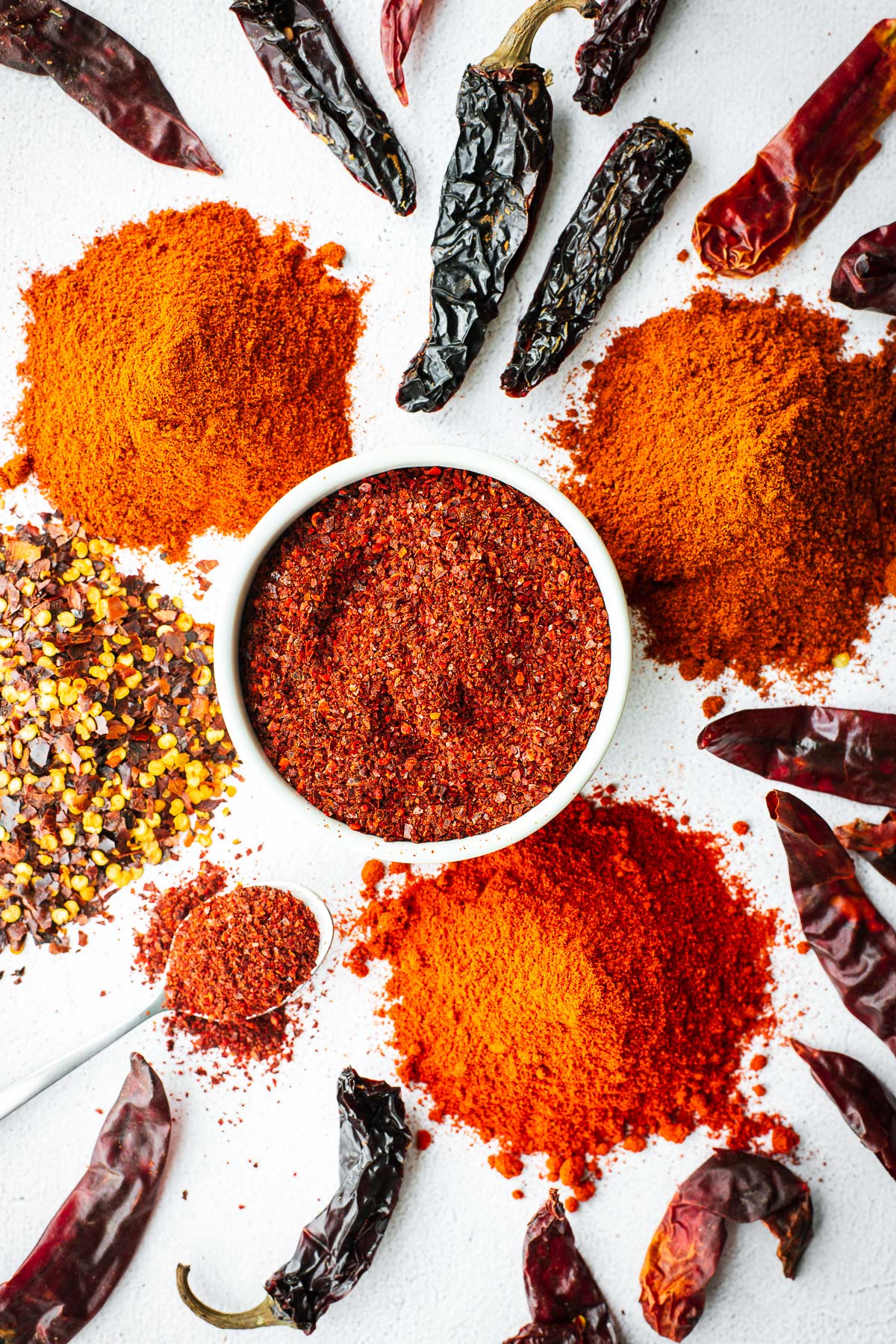
What is gochugaru?
Gochugaru is a seedless Korean chilli powder. In Korean, gochu means chilli pepper, and garu is powder. It is an essential pantry staple in Korean cooking.
A Korean chilli pepper (also called gochu pepper) is a medium-sized pepper of the species Capsicum annuum with a mild flavour. Green (unripe) Korean hot peppers measure around 1500 Scoville heat units.
The Cheongyang chilli pepper makes a hot gochugaru. It looks similar to regular Korean peppers but is much spicier. These medium-sized chillies are also of the Capsicum annuum species but with an intensity of 10,000 Scoville heat units.
Capsicum annuum includes paprika, bell peppers, serrano, poblano, padrón, mirasol (Guajillo chilli in its dried form), jalapeño, chile de Árbol, cayenne, cascabel, bird’s eye, and Aleppo peppers.
What does gochugaru look like?
Gochugaru has a vibrant red colour, and the texture varies from fine powder (Korean chilli powder) to coarser flakes (Korean chilli flakes). Deseeded, dried peppers are ground to create these distinctive tiny flakes.
Because the mix does not include seeds, the texture of the crushed chilli flakes is much finer than Western crushed red pepper flakes. It makes red pepper flakes a less-than-ideal substitute for gochugaru, but they can work in a pinch.
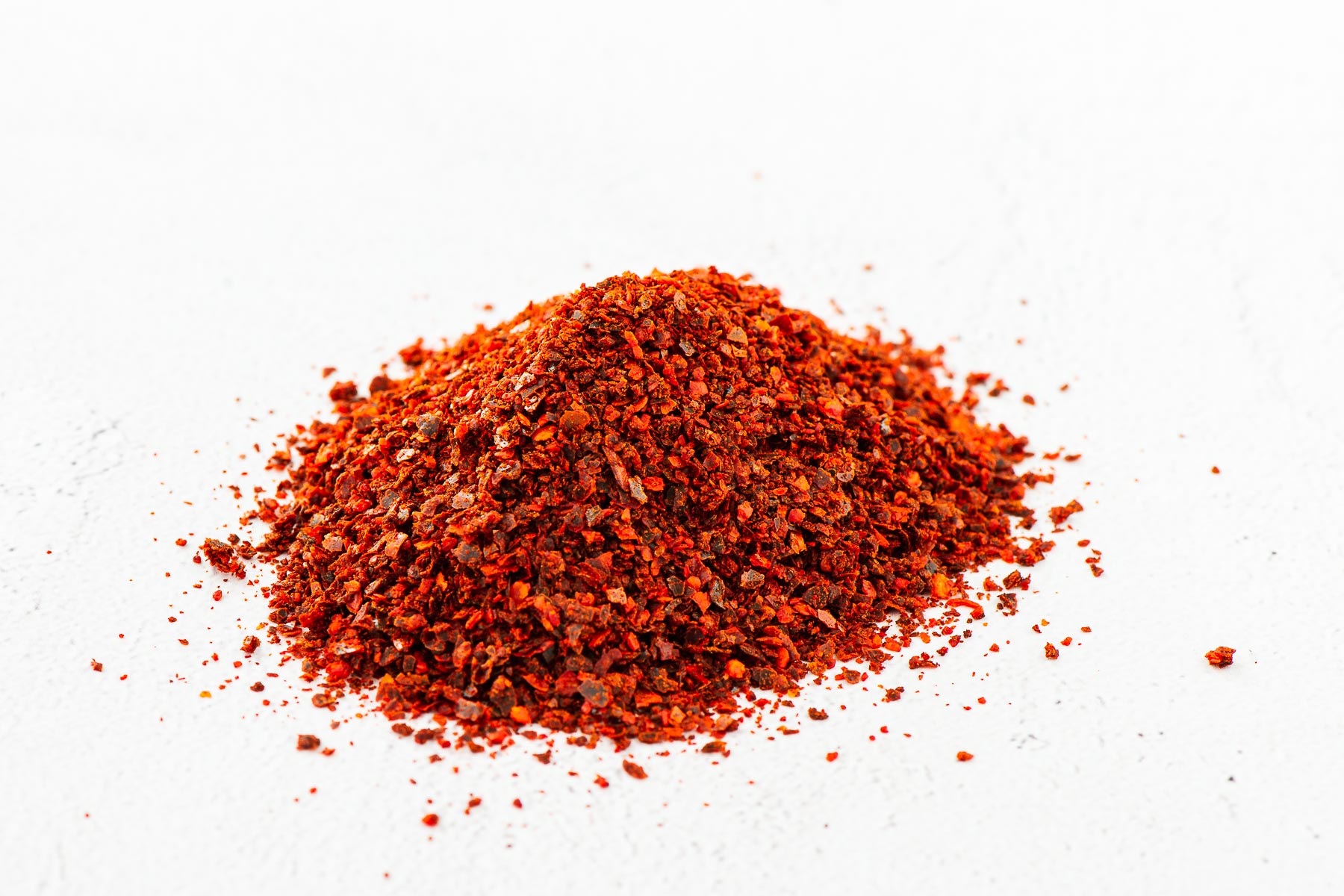
What does Gochugaru taste like?
Gochugaru is spicy, with a complex flavour profile. It has a sweet and slightly smoky taste. Its spiciness range from mild to moderately hot.
The intensity of gochugaru varies greatly. Mild gochugaru is called deolmaewoon gochugaru (or Deol-Maewoon), and the hottest variety is maewoon gochugaru.
What is taeyangcho gochugaru?
Taeyang means sun in Korean, and taeyangcho (or taeyang-cho) gochugaru refers to sun-dried Korean chilli peppers. Whereas standard gochugaru may be industrially heat dried.
This traditional taeyangcho gochugaru has a more vibrant red colour. But it is also more expensive. If you can, look for “taeyangcho” on the packaging to find the best quality gochugaru.
How is gochugaru used in Korean cuisine?
Gochugaru is best known for its use in kimchi.
But it’s a common ingredient in many Korean recipes, like yukgaejang (spicy beef soup), dubu jorim (spicy braised tofu), sundubu jjigae (spicy soft tofu stew), kongnamul muchim (soybean sprout side dish), and oi muchim (spicy cucumber salad). All of these Korean dishes get their spicy kick from gochugaru.
Korean recipes with gochugaru
Gochugaru is an essential ingredient found in most Korean kitchens.
Coarsely ground gochugaru is used for kimchi and other dishes such as stews and soups. And finely ground gochugaru makes the best gochujang.
Gochugaru vs Gochujang
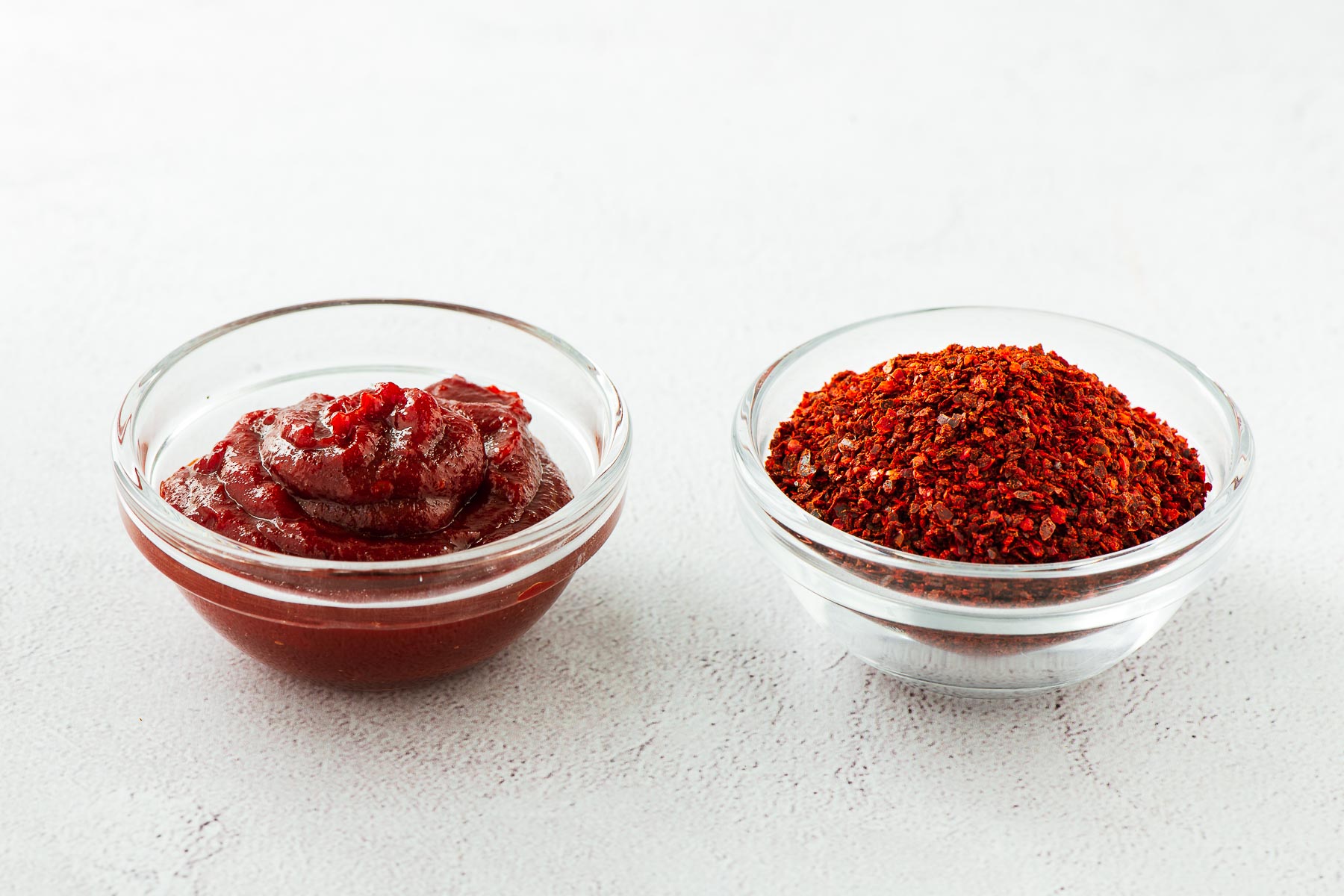
Gochujang (also gochu-jang, Korean red chilli paste or hot pepper paste) is a spicy Korean fermented paste.
Gochugaru is one of the main ingredients in gochujang paste, along with glutinous rice powder, barley malt powder (yeotgireum), fermented soybean powder (meju), and salt.
The paste has a dark, red colour with an intensely savoury, sweet, spicy, and almost smoky taste. The sweetness is from the starch of cooked glutinous rice, cultured with enzymes during fermentation. Like gochugaru, gochujang is available in different levels of spiciness.
One of the main differences between gochugaru and gochujang is the appearance and texture. Gochujang is a thick paste, while gochugaru is a powder.
In terms of taste, gochujang has a salty umami taste. And gochujang is much sweeter than gochugaru.
You can make your own gochujang at home, but it requires a lengthy fermentation process. Luckily, you can also make a homemade substitute for gochujang with gochugaru, miso paste, soy sauce, maple syrup, and a few flavour boosters. See the blog post for the full recipe and more gochujang substitutes.
Related Post: The best gochujang substitute and what not to use.
The best substitutes for gochugaru
Just because gochugaru is impossible to track down in your local grocery store doesn’t mean you have to miss out on making delicious Korean food at home!
While Korean gochugaru has a distinctive, spicy taste, many varieties of chilli flakes and powders can give your Korean recipe the kick it needs.
Measuring the spiciness of chilli powder alternatives
To find a good substitute, we need a unit of measurement to classify the spiciness of different chillies.
The Scoville scale is just that, a measurement for the spiciness of chilli peppers. Scoville heat units (SHU) measure the concentration of capsaicinoids. Using Scoville heat units, we can look for the best substitute for mild or hot gochugaru.
Gochugaru generally falls between 1,500 to 10,000 Scoville heat units.
Taking into consideration what we’ve learned about gochugaru, we know that the perfect substitute for gochugaru is:
- a seedless chilli powder,
- with a bright red colour,
- a sweet, almost smoky taste,
- that registers between 1,500 and 10,000 Scoville Heat Units.
Now, let’s consider the best alternatives for every gochugaru use case.
1. Aleppo pepper flakes: The best substitute for hot gochugaru
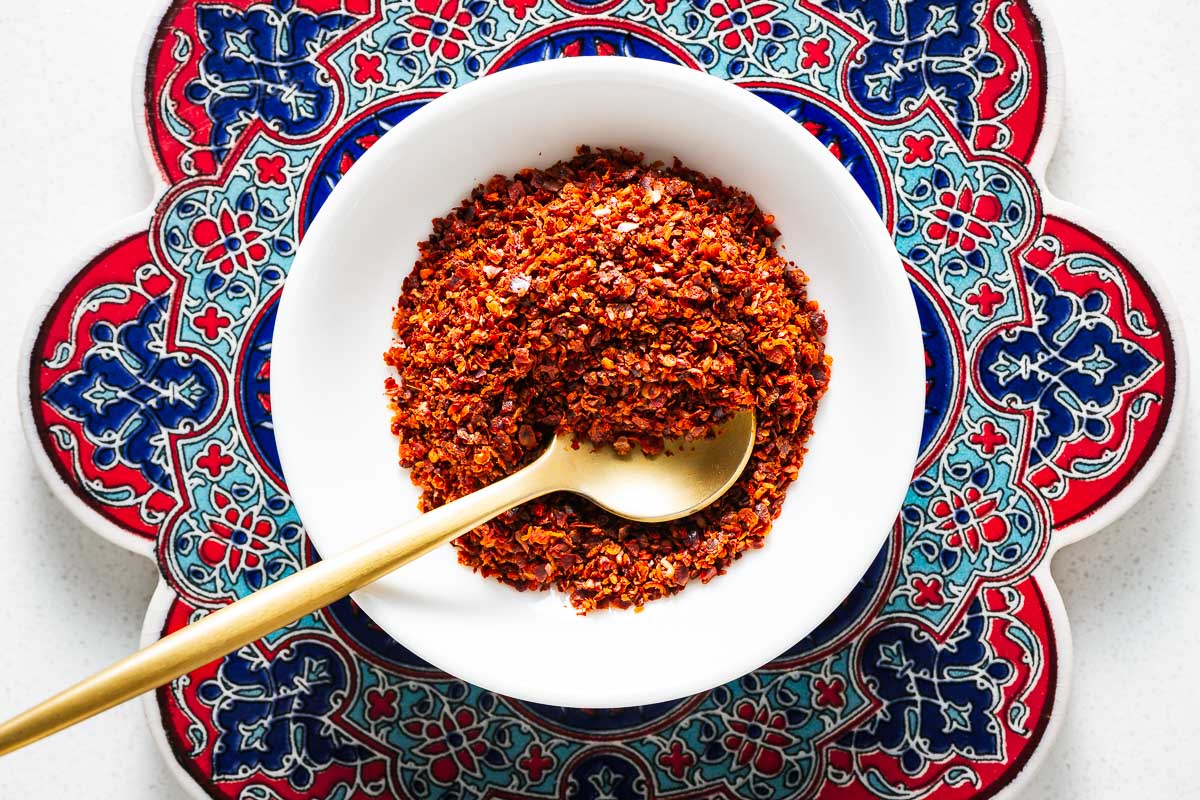
The Aleppo pepper (or Halaby pepper) is another variety of Capsicum annuum. It is most common in Turkish, Middle Eastern and Mediterranean cuisine. Dried Aleppo pepper is the third most common spice in Turkey (after salt and black pepper).
In Turkey, the flakes are called pul biber (pul means flake and biber means pepper). Armenian dried Aleppo pepper powder is called Halebi bibar.
To make Aleppo pepper flakes, fully ripened Aleppo peppers are semi-dried, deseeded and crushed or coarsely ground. The Aleppo pepper has a moderate heat level of around 10,000 SHU, matching the Cheongyang pepper used for hot gochugaru flakes.
It also has a slightly sweet flavour, with some fruitiness and mild, earthy undertones, and a substantial kick.
Learn more about Aleppo pepper flakes.
2. Kashmiri chilli powder: The best substitute for mild gochugaru
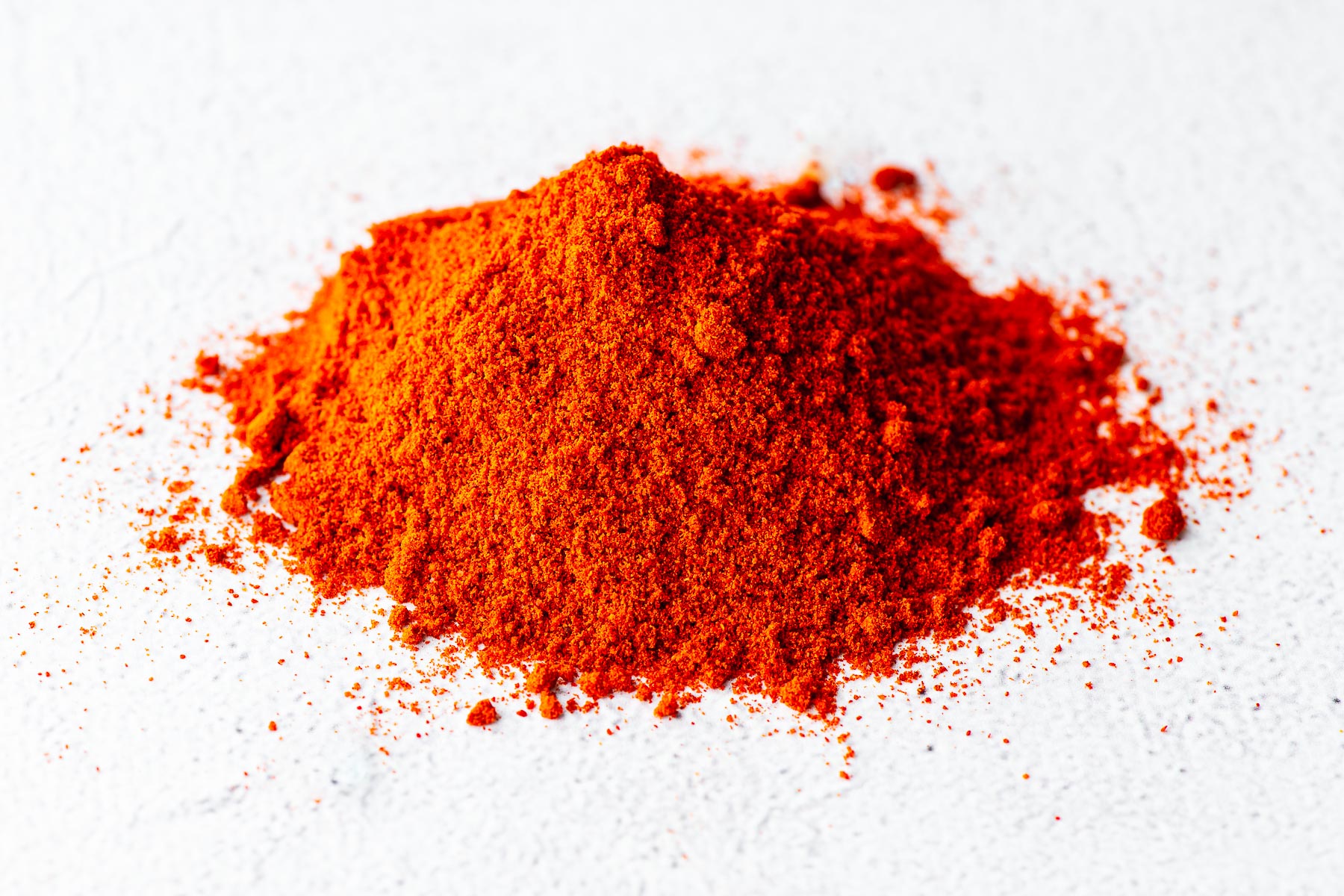
This Indian chilli powder imparts a beautiful red colour to food without risking an overly spicy dish. It also has a sweet, slightly smoky flavour with a fruity aroma.
Kashmiri red chillies are mild with a heat index of 1,000 to 2,000 SHU. India is the largest producer and consumer of these chillies. It is a common ingredient in Indian curries, soups, stews, sauces and marinades.
Use Kashmiri powder as a direct substitute for mild gochugaru powder.
Try it in this easy homemade gochujang substitute recipe.
3. Paprika: The best pantry staple substitute for gochugaru

While Aleppo pepper flakes and Kashmiri chilli powder are excellent substitutes for hot and mild gochugaru, they are also less common ingredients.
Paprika is a fine red pepper powder that ranges from mild to hot. Hot paprika can be an excellent substitute for gochugaru, but mild paprika won’t deliver the spicy kick to hot dishes. Taste your paprika and if it is particularly mild, add a pinch of cayenne powder.
Or, if you want a substitute for the sweet and smoky flavour of gochugaru, but without the heat, mild paprika is your friend!
The best gochugaru substitute for kimchi
The best replacement for the gochugaru flakes in kimchi is Aleppo pepper flakes. It matches the intensity of hot gochugaru and has a similar texture thanks to the deseeded crushed peppers.
But you can also use Kashmiri chilli powder for a milder version or paprika with a pinch of cayenne powder.
Or make your own gochugaru substitute from ground deseeded dried chillies.
Gochugaru is seedless, so don’t use Western red pepper or cayenne pepper flakes unless it is all you have. Both contain seeds, and cayenne pepper is significantly spicier.
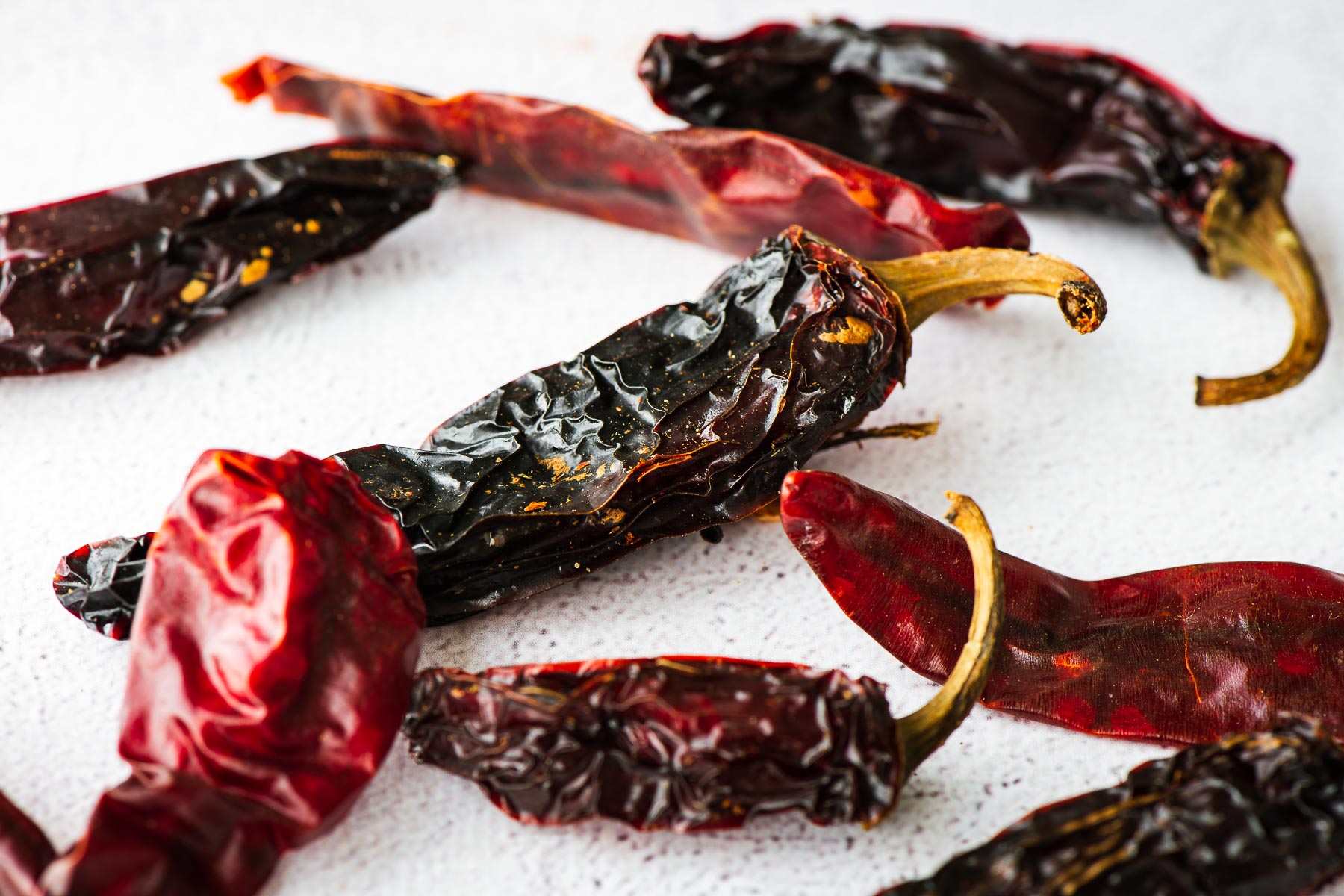
How to make a gochugaru substitute from whole dried chillies
To make red pepper flakes, deseed your whole dried chillies and bash in a mortar and pestle for a coarse, flaky powder or blitz in a spice grinder for a fine powder.
The best dried chillies to use for a gochugaru substitute are:
- Ancho chiles: Anchos are dried poblano peppers used in Mexican cuisine. They have a subtle smokiness and a fruity taste. They measure about 1,000 to 1,500 SHU. Homemade ancho chile powder makes a great substitute for mild gochugaru.
- Chipotle peppers: Chipotles are smoke-dried red Jalapeños. They are much smokier than gochugaru and have a much darker colour. But they have a similar underlying sweetness and range from 2,500 to 8,000 SHU. Chipotle powder is a great moderately spicy alternative.
- Chile de Arbol: These dried chillies pack quite a punch! Their heat index is between 15,000 and 30,000 SHU. So, if you use them to make a gochugaru alternative, substitute half a teaspoon of chile de Arbol powder for each teaspoon of gochugaru.
You can also try chile pasilla (1,000 to 3,999 SHU), Mulato pepper or “Chile Mulato” (2,500 to 3,000 SHU), or guajillo chili (2,500 to 5,000 SHU) for homemade guajillo powder.
Frequently asked questions
No, you can’t use gochujang paste and gochugaru interchangeably. Gochugaru is pure dried Korean chilli peppers, whereas gochujang is a fermented red chilli paste made from gochugaru. Both gochugaru and gochujang can vary in spiciness.
The texture is the first noticeable difference between the two products. But there is also a difference in taste. Gochugaru has no salt, while gochujang is very salty. Gochujang is also much sweeter.
That said, in soups and stews, you can use a teaspoon of gochujang instead of gochugaru for a spicy kick. Adjust the amount of salt you add to the dish.
Different chilli powders can have different flavour notes, spice levels and textures. Try to stick to seedless chilli flakes or powder for the best substitute.
Also, check the spice level of the chillies and adjust your quantities accordingly. Gochugaru has a heat index between 1,500 and 10,000 Scoville heat units.
Yes, but you need to deseed them first, then bash or blitz them into flakes or powder.
You can find gochugaru in the Asian ingredient aisle in many grocery stores, or in a speciality Asian grocery store. If you struggle to track it down, Amazon is your best bet. But luckily, there are many great substitutes once you understand the main characteristics of gochugaru.
Use gochugaru in these Korean recipes
- Homemade gochujang substitute with fine gochugaru powder.
- Spicy Korean cucumber salad (oi muchim) with gochugaru flakes.
- Or add some spice to this Korean sesame broccoli salad.
- And try a refreshing Korean green onion salad with a spicy kick.
- Or sprinkle gochugaru on Korean soy-braised potatoes for a spicy twist.
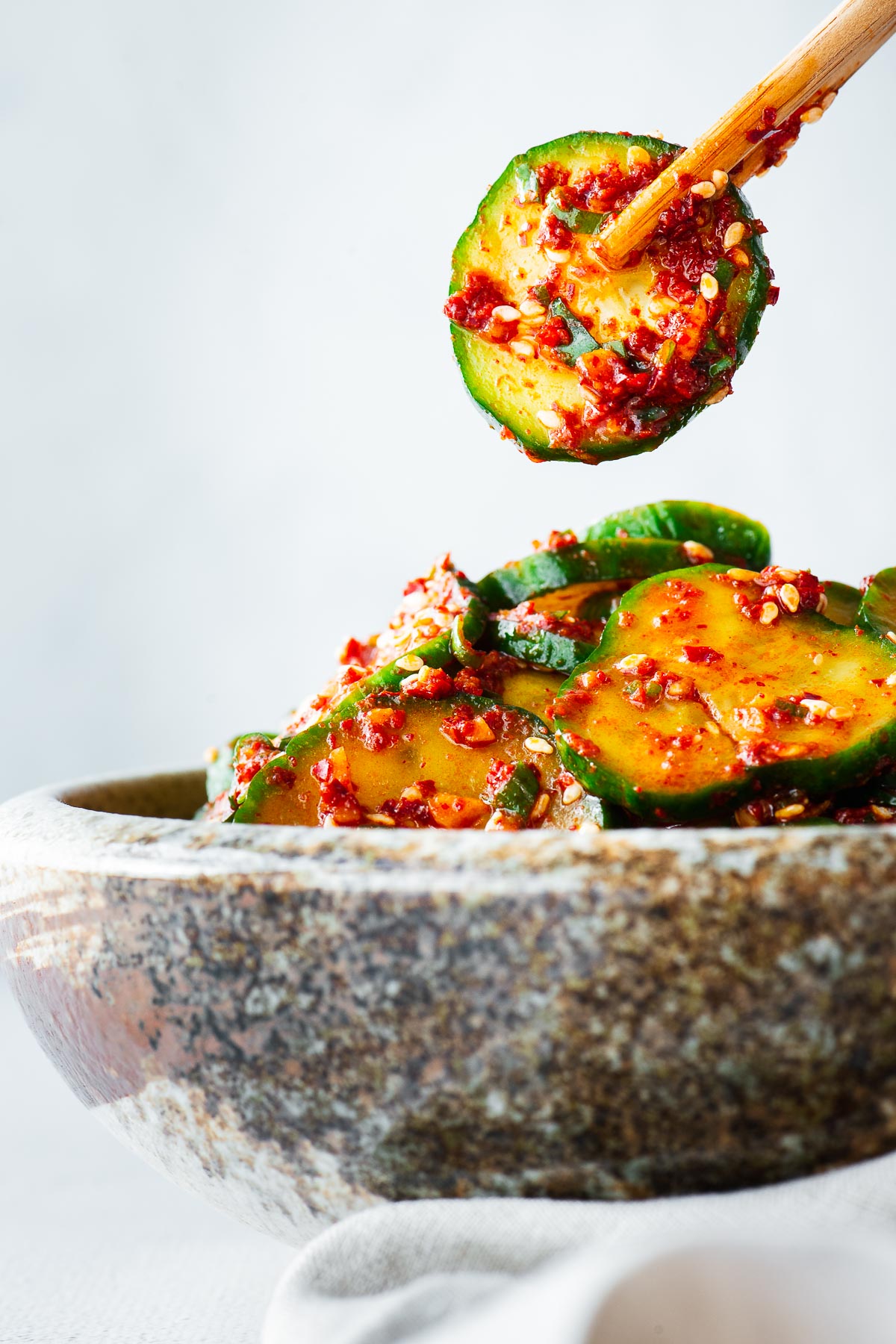
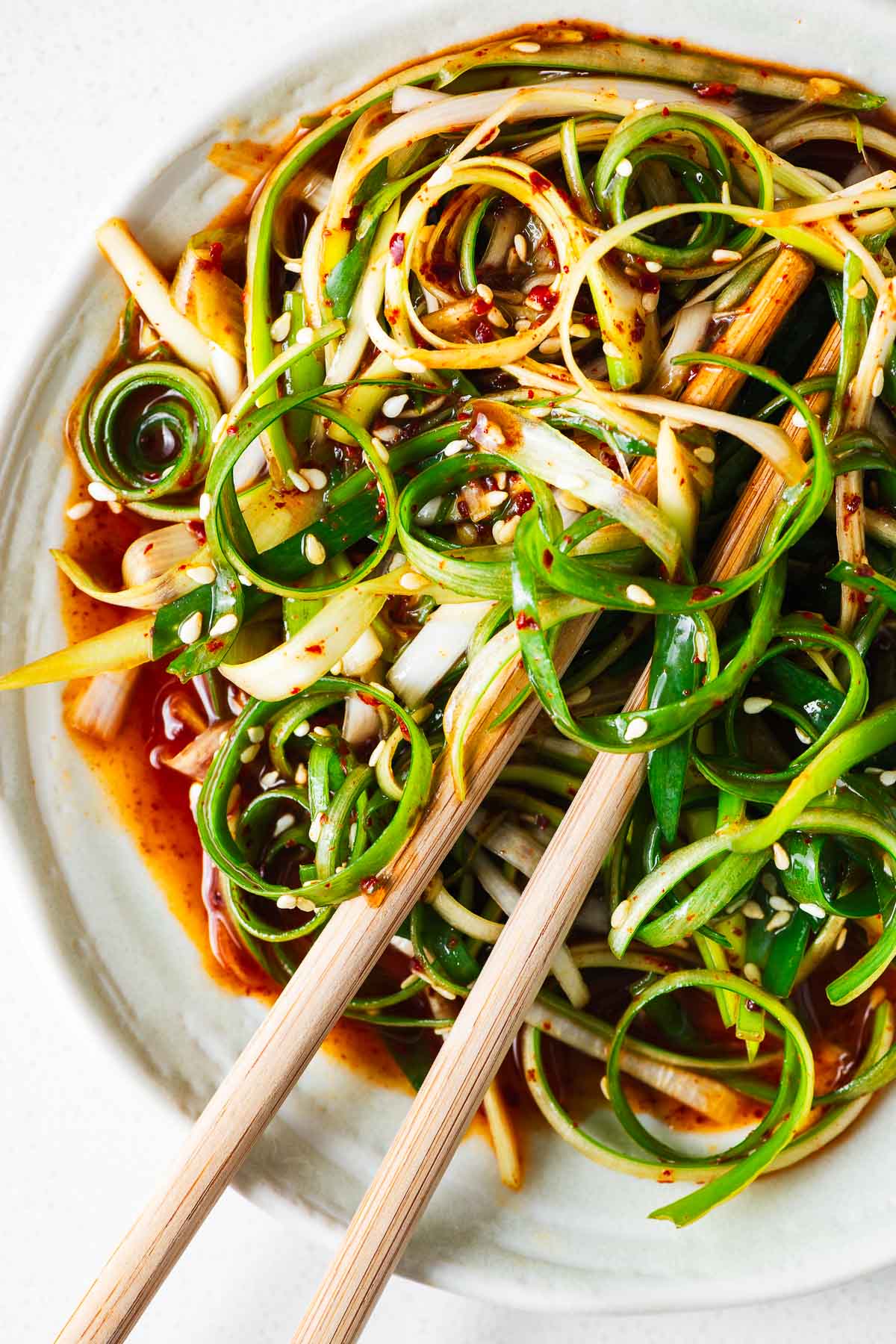
Summary
Korean red pepper flakes ranges from mild to moderate intensity (1,500 to 10,000 Scoville heat units). It has a vibrant red colour and a sweet, spicy flavour with a hint of smokiness. The texture is either a fine powder or coarsely ground flakes (without seeds).
Pul biber (made from Aleppo pepper flakes) is the best substitute for hot gochugaru, and Indian chilli powder (Kashmiri chilli powder) is best for mild gochugaru. If you don’t love spicy food, you can reduce the heat of your dish by using sweet paprika and adding as much heat as you can tolerate with cayenne pepper, one small pinch at a time.
Or make ground chilli flakes from deseeded dried chillies.
While these are the best substitutes, you can use any other chilli flakes or powder in a pinch. Just keep the intensity of the pepper in mind and look for dried chilli flakes without seeds.
More interesting ingredient substitutes

Can I use la Chinata smoked paprika powder instead of gochugaru
Hi Bernadette, la Chinata smoked paprika powder is much smokier than Korean gochugaru. But you can certainly use it as a gochugaru subsitute, your dish will just have a more smoky flavour which (if you love smoky flavours as I do) is not a bad thing. La Chinata is available in Sweet, Bittersweet, and Hot. If you have sweet paprika, you can add a pinch of cayenne pepper to boost the heat a bit. Let me know if you have any more questions, I’m always happy to answer.
Your website looks interesting.
Don’t know if you’ll want this…but ‘chili’ has one L, rather than 2.
(Some people get angry; some are grateful. What can you do?🤷♀️💜)
Hi Lise,
I’m glad to hear you find my website interesting!
And thank you for taking the time to point the spelling out. I’m always happy to receive feedback.
And you’re right, chili is spelt with one “L” in American English. But in British English, it is spelt with two. It’s just one of the many little (sometimes frustrating) differences between the two. :-)